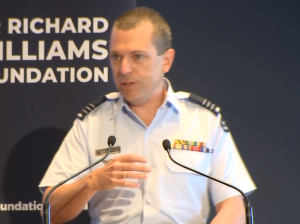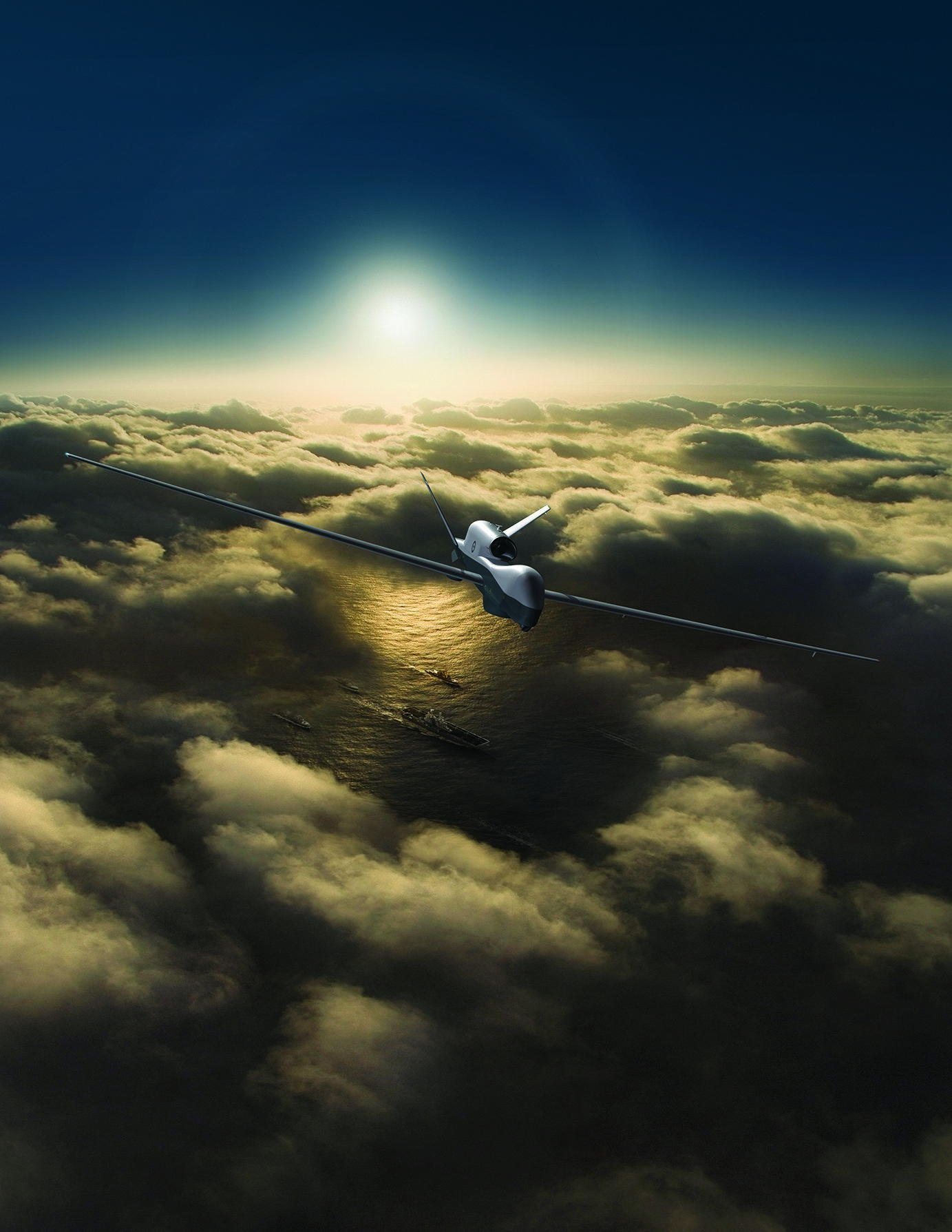The Quest for Next Generation Autonomous Systems: Impact on Reshaping Australian Defence Forces
At the April 8, 2021, Williams Foundation Seminar on Next Generation Autonomous systems, the moderator was WGCDR Keirin Joyce. I had met Joyce at an earlier Williams Foundation presentation on unmanned systems and had a chance to follow up on his take on the issues discussed at the seminar in a phone interview on May 14, 2021.
When I first met Joyce he was in the Army working on unmanned systems; now he was working Triton and Sky Guardian. He has served for 24 years in the Australian Army, where he last served as Program Manager of Unmanned Aerial Systems from December 2016-January 2020. Since then, he is serving in the Royal Australian Air Force as Chief Engineer for Royal Australian Air Force Remotely Piloted Aircraft Systems / Unmanned Aerial Systems at ISR Systems Program Office, including MQ-4C Triton under Air 7000-1B and MQ-9B SkyGuardian under Air 7003.
Precisely because he has been involved with two services and is knowledgeable with regard to the civilian side of artificial intelligence and robotics, he was the perfect choice to be the seminar moderator.
During the seminar, he highlighted an example of how current forces can use new unmanned technologies to support the evolving kill web, in which a small team with ISR and C2 capability can inform a firing solution by a virtual task force firing solution provider. mWGCDR Joyce noted that in an Exercise Hamel held in 2018, a two-man Army team using a Black Hornet Nano UAV were able to identify a tank formation, and then with their radio able to pass that information on to the RAAF for a strike opportunity against that tank formation.
This example highlights certainly one role which unmanned systems can play in providing ISR better labelled as information than intelligence surveillance reconnaissance because in this case you have the two-man team inside the weapons engagement zone (WEZ) providing input to an external provider not organic for a firing solution.

The first issue we discussed was the importance of understanding the challenge of generating innovation associated with autonomous systems into the operational military.
The military as an organization is often described as risk averse, but since the military has to be prepared to fight tonight, disruptive change for its own purpose can degrade military capabilities rather than enhancing them.
The ADF has been described through Williams Foundation seminars since 2014 as building a fifth-generation force.
In my own words, I see this as shaping an integrated distributed force through which kill webs can operate to provide for a scalable combat force.
With such a template, the role of next generation autonomous systems can enable either enhanced mass to modular task forces, or enhanced decision-making capability either at the tactical edge or at the wider tactical or strategic decision-making levels.
As Joyce put it: “we know that we have to go to war with what we’ve got. When you go to the next big thing in defense, you proceed from what you already have.”
The second issue was the key role in which Australia finds itself with regard to working next generation autonomous systems.
As Joyce noted: “We are recognized as a global leader in autonomy in the mining and resource sector, both ground and aerial survey autonomy. I think a lot of that technology is able to be brought across to defense or upscaled towards defense applications.”
As a key member of the five eyes community, Australian innovations have a wider market for both development and deployment. Australia also can draw upon innovations being shaped by the other five eyes members, and as Canada, the UK, and the U.S. particularly do not have the same geographical defense needs, there will clearly be different approaches to incorporating next generation autonomous systems into their forces.
As Joyce underscored: “I think there is a melting pot of technology built in Australia that we’re good at and we have a lot of potential to contribute on a global scale.”
The third issue is the cross between the first and second points: Australia is already building a fifth-generation force which enables further innovation as well.
With regard to the fifth-generation force, the core role of software has clearly emerged as a key element of change.
As forces get more used to how to manage software upgradeability in current platforms, a learning cycle is being shaped whereby systems which are built primarily around software – the next generation autonomous systems – will become key elements for force transformation.
With the shift to the digital native generation of warriors, innovation processes are changing as well.
WGCDR Joyce used the example of the potential impact of drone racers on military innovation.
“The Drone Racing Teams of the Army, Navy, and Air Force are a key force for change. These are kids that have decided to take up drone racing in their spare time. None of them are employed to do this full-time. They have taken it off as a hobby and not through university, not through technical college, but off You Tube videos and collaborative communities that have taught themselves all the skills on how to build a UAV. They literally learn it all on You Tube, and they have this amazing skill set that sits at a peer level and in some cases in advance of our socially qualified engineers.
“In Australia we’ve used these drone racing pilots in support of our weapon’s technical investigations and intelligence, in support of rapid prototyping, assisting with ground autonomy trials, and all of these soldiers and aviators are doing this in their spare time.
“I think it’s something that we need to tap more and to develop deployable rapid prototyping labs, or deployable space labs. In the future it’s plausible that when we are confronted with the next asymmetric threat that our opposition force comes up with, there is absolutely the possibility that we can design, prototype and manufacture solutions, not by engineers, but by people who just know how to do it and have taught themselves how to do it because it’s fun. I think that is a real skill set that we should be focusing on and tapping: it is an opportunity that costs next to nothing.
“Perhaps we should be setting up structures in our organizations where we let these people do their day job one posting, and then on the next posting their whole job is just running or contributing to innovation labs. And then they go back to their job, and then they go back to the innovation lab. We could really foster those skill sets and thought processes and innovative approaches to whatever sixth Gen is, because when we take our Fifth-Gen Force to the next battle, we go with what we’ve got.
“And if we want to rapidly uptake that force to a Generation 5.1, or a Generation 6 application, then we are going to need skills to do that. Most of the skills needed are in code, in electronics, software, and in data: drone racers.”
The fourth issue is the relationship between the broader ecosystem for robots, AI and autonomy and finding ways for the military to tap into that broader ecosystem.
WGCDR Joyce underscored how important being able to do so was for the Australian military and he provided an example of such a case.
“One case study in particular is prototyping an aircraft for the eVTOL market for unmanned aerial taxis. There’s a company out of Sydney called AMSL.
“They’re doing it for the commercial market. But they have partnered with Defence to take the five-passenger seats out and design a configuration for us to do 500 to 600 kilograms worth of combat resupply.
“We have asked them as well to do the design work that when that airplane is otherwise coming back empty from doing a resupply that we could also put in up to two stretchers for casualty evacuations.
“They are already doing the collaborative research with telemedicine and automated monitoring of stretcher-bound patients.
“All of that technology is coming in from the medical tech field, and that’s being underpinned not necessarily by defense or even the medical field, it’s by our civilian medical evacuation helicopter providers, people like CareFlight who provide some of our emergency response helicopters for our ambulance services.”
The fifth point is where the quest for next generation autonomous systems fits into the evolution of the art of warfare.
This can be looked at in two different ways: one the specific defense geography of Australia and secondly, the strategic shift from the Middle Eastern land wars to operating in conflict with peer competitors.
This first revolves around shaping the distributed integratable force in which combat clusters can operate at the tactical edge with enough capability to achieve their tasks as allocated by mission command requirements. Distribution is about working multi-domain warfighting packages. Next generation autonomous systems can provide increased mass for each combat cluster notably with ISR payloads already on the way.
The second revolves around the geography of Australia. Given the importance of Western to Northern Australia to the first island chain of the Solomon Islands, there are a number of ways next generation autonomous systems can provide for capabilities throughout the distributed operational space.
For example, port security at a distance is a crucial requirement. Already, autonomous maritime USVs exist with the relevant ISR systems to provide significant inputs to meeting this mission.
As the ADF works through how best to build a defense grid over this region for its operations, it makes a great deal of sense to build in new autonomous systems as players in that defense grid. This solves a key problem which is where to add new capabilities without degrading extant capabilities, for as you build out a new approach to an operational area building in new platforms and systems can be done with realism in terms of delivering a desired combat capability, rather than just building prototypes or briefing slides, more likely to put your audience asleep than building capabilities which deter an adversary.
And finally, we discussed Triton.
WGCDR Joyce has Triton in his portfolio, and I have visited Jax Navy several times as well as RAAF Base Edinburgh where the P-8s and Tritons will be operated from.
The point can be made simply: This is a U.S. Navy led effort on manned-unmanned teaming NOW and lessons learned from such teaming clearly inform a way ahead for next generation autonomous systems.
In short, next generation autonomous systems are clearly on the way.
As WGCDR Joyce underscored: “All of the services see robotic autonomous systems as a significant part of the road ahead. It’s just that the services are getting after them differently.”
And this was highlighted during the seminar and will be the focus of later pieces on the seminar.
The featured graphic is of a MQ-4 Triton with an LHD in the rear of the graphic.

